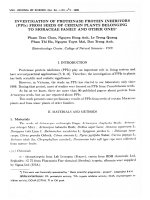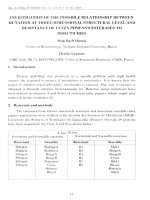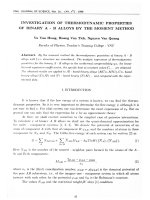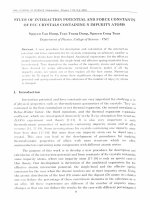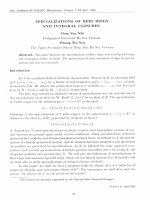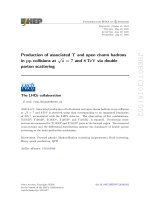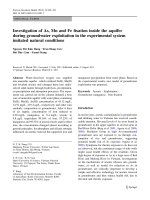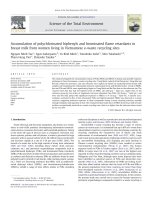DSpace at VNU: Investigation of As, Mn and Fe fixation inside the aquifer during groundwater exploitation in the experimental system imitated natural conditions
Bạn đang xem bản rút gọn của tài liệu. Xem và tải ngay bản đầy đủ của tài liệu tại đây (389.05 KB, 6 trang )
Environ Geochem Health (2012) 34:349–354
DOI 10.1007/s10653-011-9401-7
ORIGINAL PAPER
Investigation of As, Mn and Fe fixation inside the aquifer
during groundwater exploitation in the experimental system
imitated natural conditions
Nguyen Thi Kim Dung • Tran Hong Con
Bui Duy Cam • Yumei Kang
•
Received: 21 March 2011 / Accepted: 13 July 2011 / Published online: 9 August 2011
Ó Springer Science+Business Media B.V. 2011
Abstract Water-dissolved oxygen was supplied
into anaerobic aquifer , which oxidized Fe(II), Mn(II)
and trivalent arsenic and changed them into undissolved solid matter through hydrolysis, precipitation,
co-precipitation and adsorption processes. The experiment was carried out on the column imitated a bore
core of anaerobic aquifer with water phase containing
Fe(II), Mn(II), As(III) concentration of 45.12 mg/L,
14.52 mg/L, 219.4 lg/L, respectively and other ions
similarly composition in groundwater. After 6 days
of air supply, concentration of iron reduced to
0.38 mg/L, manganese to 0.4 mg/L, arsenic to
9.8 lg/L (equivalent 99.16% of iron, 97.25% of
manganese and 95.53% of arsenic fixed), and for other
ions, the concentration changed almost according to
general principles. Ion phosphate and silicate strongly
influenced on arsenic removal but supported iron and
N. T. K. Dung (&)
Haiphong Private University, 36 Dan Lap Street,
Le Chan District, Hai Phong, Vietnam
e-mail:
T. H. Con Á B. D. Cam
Hanoi University of Science, Vietnam National
University, 334 Nguyen Trai Street, Thanh Xuan,
Hanoi, Vietnam
Y. Kang
Laboratory of Soil Environmental Science, Faculty
of Agriculture, Kochi University, Monobe B200,
Nankoku City, Kochi 783-8502, Japan
manganese precipitation from water phase. Based on
the experimental results, new model of groundwater
exploitation was proposed.
Keywords Arsenic Á Exploitation Á
Groundwater manganese Á Iron fixation
Introduction
In recent years, arsenic contamination in groundwater
and drinking water in Vietnam has received considerable attention. Elevated levels of As were found in
groundwater in the upper aquifers in several areas in
Red River Delta (Berg et al. 2001; Agusa et al. 2006,
2009). Residents living in high As-contaminated
groundwater area are exposed to As through consumption of rice and groundwater, suggesting
potential health risk of As exposure (Agusa et al.
2009). Symptoms for chronic exposure to As have not
yet observed, but the continuous usage of tube wells
might cause health effects of the residents. Given
high degree of exposure to As in a large area of Red
River and Mekong River in Vietnam, investigations
on the mechanisms of arsenic releases into groundwater, as well as model for reduction in As in
groundwater, are critically important to develop a
simple and effective technology for arsenic removal
in groundwater and thus reduce health risk due to
elevated and chronic exposure.
123
350
In the aquifer, under anaerobic conditions, iron
and manganese exist as divalent species and arsenic
as almost nondissociated trivalent arsenious acid
(Con et al. 2002; Nriagu 1994; Saha et al. 1999). In
order to remove iron from underground water, traditional technology used aeration technique to oxidize Fe(II) to Fe(III) and then separated it from water
in the form of insoluble Fe(III). For manganese
removal, normally use filtration through sand-coated
MnO2 (Chang et al. 2010). For groundwater contaminated by arsenic, there were many methods and
technologies for arsenic treatment, especially since
‘‘largest poisoning in the World’’ at Bangladesh
revealed in 1993 (Chang et al. 2010; Chakraborti
et al. 2010). Our recent study has showed that during
and after oxidation of Fe(II) to Fe(III), Fe(III)
immediately hydrolyzed to form almost insoluble
Fe(OH)3 and the iron hydroxide species strongly
adsorbed arsenate anions and partly co-precipitated
with manganese (Dung et al. 2009). We investigated
fixation capabilities of iron, manganese and arsenic
on equipment imitated natural conditions of the
aquifer. During the fixation of iron, manganese and
arsenic, the expected influencing factors such as
phosphate, silicate, NO3-, NH4? and SO42- concentrations were also investigated. Experiment result
of this study was applied for fixation of iron,
manganese, arsenic inside aquifer and reduction in
ammonium concentration in exploited water. The
underground water exploitation model was established based on the idea that underground water after
pumped up was saturated by air oxygen. Part of
the oxygen-saturated water was pumped back to
exploited layer to do fixation of iron, arsenic and
manganese, and other part was filtrated to do supply.
Experiment
The experimental system was installed as described
in Fig. 1. The research column was filled 50-mm
layer of weathering gravel in bottom, next was
600-mm layer of sand mixed with 0.001% of As in
the form of arsenate, 0.01% of Mn in the form of
MnO2 and 0.1% of Fe in the form of Fe(OH)3 (w/w
percentage). The main components in water phase are
listed in Table 1.
Before fixation investigation, the experimental
system (Fig. 1) was running with circulation of water
123
Environ Geochem Health (2012) 34:349–354
1
10
(6)
8
(5)
3
(4)
2
6
(3)
(2)
(1)
7
9
4
5
Fig. 1 Schematic diagram of the research system, 1. Column
head, 2. Thermoisolation cover, 3. Layer of sand, MnO2,
Fe(OH)3, undissolved As(V) and other components, 4. Weathering gravel layer, 5. Porous membrane, 6. (1)-(6) Sampling
valves, 7. Peristaltic pump, 8. Regulation tank, 9. Thermostat, 10.
Air supply device
Table 1 Main composition of water phase (Berg et al. 2001)
Component
Concentration (M)
Ca2?
1.0 9 10-3
-
HCO3
2.4 9 10-3
-
NO3
SO42-
3.0 9 10-4
5.2 9 10-4
PO43-
3.0 9 10-5
Mg2?
6.0 9 10-5
Digestible organic matter
1.2 9 10-3 (glucose)
phase and air tightening for 50 days in order to create
anaerobic condition in inner system similar to
condition in natural aquifer.
The investigation started when air was continually
supplied to the regulation tank with a rate of 0.5 L/min.
Samples were taken daily at fixed time from valve (6)
Environ Geochem Health (2012) 34:349–354
351
Table 2 Analysis methods APHA, AWWA, WEF (1995)
Parameter
Analysis method
As
AAS-HVG method
Fe, Mn
F-AAS method
NO3-,
Phosphate
Cadmium reduction method
Stannous chloride method
Silicate
Molybdosilicate method
SO42-
Methylthymol blue method
NH4?
Phenate method
at the experimental column, and parameters were
analyzed triplicate by the methods listed in Table 2.
Fig. 2 Variation in Fe, Mn, As concentrations, ORP and DO
versus air supply time (sampling from valve 6)
When air oxygen was supplied into system, dissolved
oxygen concentration (DO) increased along with
bubbling time and reached near 8 mg/L after 10 days
(the system changed into almost aerobic condition).
Changing nature of the system from anaerobic to
aerobic caused variation in almost all constituents in
the system (Fig. 2).
Together with increasing in DO, ORP of water
phase also increased regularly. It was inevitable.
dissolved forms of iron(II) and arsenic(III) from
fresh and unstable precipitate species of iron
arsenide and sulfide (Dung et al. 2010). In the
following days, the system was in oxygen-rich
condition, iron(II) oxidized into iron(III). This
species started to hydrolyzed and precipitated as
undissolved Fe(OH)3. That is why iron concentration decreased. In this condition, arsenite
species also slowly oxidized into arsenate in the
form of anions hydoarsenate and started to coprecipitate with iron(III) hydroxide or to adsorb
onto surface of iron(III) hydroxide particles. So
total arsenic concentration in the system also
decreased (Dung et al. 2009). When system was
almost in the aerobic condition, the concentrations of iron as well as arsenic decreased to
meet limited concentrations of 0.50 mg/L and
0.010 lg/L, respectively. The results of samples
collected from valves 1–5 showed the similar
law of elements’ concentration variation and
transformation but the time to reach aerobic
condition was earlier from valves 1–5.
In case of arsenic and iron, the variations were
different. In the beginning hours of oxygen
supply (about first day), the concentrations of
both elements increased. The reason of this
phenomenon could be oxidation by DO yielding
For manganese(II) ion, its concentration was
decreased continuously from beginning to the end.
The reason could be that slow oxidation of Mn(II)
to Mn(IV) by DO in neutral environment formed
undissolved MnO2. This process was less influenced
Results and discussion
Composition of water phase in anaerobic state
The composition and main parameters of water phase
in anaerobic system (after 50 days air absent running)
are analyzed (samples were taken from valve number
(6) at the experimental column and result is shown in
Table 3).
The variation in Fe, Mn and As concentrations
under influence of oxygen present
Table 3 Composition of water phase in anaerobic state
Parameters
DO
(mg/L)
ROP
(mV)
Fe
(mg/L)
Mn
(mg/L)
As
(lg/L)
NO2(mg/L)
NH4?
(mg/L)
SO42(mg/L)
PO43(mg/L)
SiO32(mg/L)
Value
0.8
-45
45.12
1.45
219.4
1.24
48.20
13.76
0.95
2.82
123
352
Fig. 3 Variations in sulfate, phosphate and silicate concentrations
Environ Geochem Health (2012) 34:349–354
Fig. 4 Variations in NH4?, NO2- and NO3- concentrations
by chemical and physicochemical processes of iron
and arsenic species in the system.
The variation in sulfate, phosphate and silicate
concentrations
For investigation of sulfate, phosphate and silicate
variations, samples were taken after interval of 2 days
each other. The result for 20-day survey is shown in
Fig. 3. There were different variations in concentrations between ions. While concentrations of phosphate
and silicate were almost unchanged, concentration
of sulfate increased during survey time. However, in
beginning 4 days, the increase rate was low in comparison with the following time.
Increasing in sulfate ion in the system was result of
oxidation process of sulfide together with arsenide in
the precipitate created before in anaerobic period.
The low increasing rate of sulfate concentration in the
system at beginning days could be consequence of
competitive oxidation reactions of iron(II), arsenic(III) and other easier oxidation species present in the
system.
The variations in NH4?, NO2-, NO3concentrations
When system in anaerobic condition, concentration
of nitrate was almost limited to analyze, nitrite was
1.28 mg/L and ammonium was 48.20 mg/L. Supplying oxygen from air supplied changed concentration
of all those nitrogen formations. Ammonium concentration slowly decreased, nitrite concentration
decreased to detection limit and nitrate concentration
increased (Fig. 4).
123
Fig. 5 Influence of phosphate concentration on fixation of As,
Fe and Mn
Influence of phosphate concentration
For investigation of influence of phosphate concentration on immobilization of arsenic, iron and manganese, phosphate solution was putted on into the
system to meet designed concentration range. The
samples were collected 8 h each after other, and
arsenic, manganese, iron were analyzed.
Based on the results presented in Fig. 5, we can see
that increasing phosphate concentration only lightly
influenced on dissolved iron and manganese. With
concentration of 20 mg/L phosphate, concentration
of total iron dropped from 0.80 to 0.54 mg/L and
manganese from 1.38 to 1.12 mg/L. The lightly
decreasing concentration of iron and manganese could
be the result of precipitation of iron and manganese
phosphate in the system. For arsenic, this was different.
Phosphate ion strongly influenced on arsenic immobilization. With the concentration of phosphate lower
than 10 mg/L, the concentration of arsenic was almost
uninfluenced; but when phosphate concentration
was higher than 10 mg/L, the adsorptive competition
Environ Geochem Health (2012) 34:349–354
353
between phosphate and arsenate ions on solid phase
appeared; therefore, concentration of arsenic sharply
increased.
Influence of silicate concentration
Investigation of influence of silicate concentration on
immobilization of arsenic, iron and manganese was
implemented similarly as case of phosphate.
The result presented in Fig. 6 showed that soluble
species of iron and manganese in the system were
almost uninfluenced by concentration of silicate. But
for arsenate ion, the situation was similar to phosphate interaction. However, the competitive power was
weaker than phosphate. Those expressed by affected
concentration of silicate was higher than phosphate
(15 mg/L vs. 10 mg/L), and angular coefficient of line
segment slope in the graph of silicate was less than
phosphate (2.150 vs. 5.342). So, in any case, the
presence of phosphate or silicate or both with high
enough concentration raised difficulties for immobilization of arsenic, iron and manganese in oxygen-rich
(aerobic) condition.
Proposal model of fixation of As, Fe and Mn
in the aquifer during groundwater exploitation
The aquifer is a water-saturated layer of sand and
gravel. Horizontal water flow rate in the aquifer is
normally 10–15 m per day. So the aquifer is underground water resource and also can play as a good
water filter. Based on our results presented above
together with exploitability of the aquifer, we have
had idea to bring some stages of groundwater
treatment process down to the aquifer. These are
aeration, iron precipitation, filtration, arsenic and
Treatment system/Oxygenation
Supply water
O2 rich current
back
Ground
water
flow
direction
Groundwater
current up
Oxidation zone
Fit-back well
Exploitation well
Fig. 7 The schema of underground water exploitation
manganese treatment stages. The oxygenation and
sterilization stages are kept on ground. The schema of
underground water exploitation is described in Fig. 7.
The production process could be that: Groundwater firstly was pumped up from first tube well to
oxygenation basin. A portion of oxygen saturation
water was pumped back to the aquifer though second
tube well. Where second well is located in front of
first well along to groundwater flow direction. Other
portion of oxygen-saturated water was used for
supply. The proportion of supply and fit-back water
portions depends on iron concentration in groundwater and oxygen saturation possibility. The distance
between exploitation and fit-back wells depends on
groundwater flow rate and exploitation capacity.
Based on the result of our study, when iron
concentration in water phase C10 mg/L, more than
98% arsenic was remained in solid phase despite total
arsenic concentration was up to 0.3 mg/L and the part
of it was oxidized from arsenide formation and
dissolved into water phase.
Conclusion
Fig. 6 Influence of silicate concentration
Supplying oxygen in the form of dissolved oxygen in
water into anaerobic system imitated natural aquifer
oxidized almost Fe(II) into Fe(III), partly Mn(II) into
Mn(IV) and arsenite into arsenate. Hydrolysis of
Fe(III) and Mn(IV) helped co-precipitation and
adsorption process of arsenate together with iron
hydroxide and manganese dioxide. The result of these
processes reduced concentration of iron, manganese
123
354
and arsenic in water phase and retained them among
sand/gravel layer in the system. Fixation of the
elements, especially arsenic, influenced by phosphate
and silicate concentrations in water phase. However,
ammonia, nitrite, nitrate and sulfate showed almost no
affect. Other oxidation processes of sulfide, ammonia
even organic mater increased supplied water quality.
Acknowledgments The authors acknowledge the financial
support from the sub-project TRIG A from Hanoi University of
Science and Dr. Michael Berg, ESTNV Manager & Scientific
Advisor Department of Water Resources and Drinking Water
to facilitate the implementation process.
References
Agusa, T., Kunito, T., Minh, T. B., Trang, P. T. K., Iwata, H.,
Viet, P. H., et al. (2009). Relationship of urinary arsenic
metabolites to intake estimates in residents of the Red River
Delta, Vietnam. Environmental Pollution, 157, 396–403.
Agusa, T., Kunito, T., Minh, T. B., Trang, P. T. K., Iwata, H.,
Viet, P. H., et al. (2006). Contamination by arsenic and
other trace elements to humans in Hanoi, Vietnam.
Environmental Pollution, 139, 95–106.
American Water Works Association. (1999). Water quality and
treatment—A handbook of community water supplies (5th
ed.). New York: McGraw-Hill Publishing Company.
APHA, AWWA, WEF. (1995). Standard methods for the
examination of water and wastewater, 19th Edn. Washington, DC: APHA.
123
Environ Geochem Health (2012) 34:349–354
Berg, M., Con, T. H., et al. (2001). Arsenic contamination
of groundwater and drinking water in Vietnam: A human
health threat. Environmental Science and Technology, 35,
2621–2626.
Chakraborti, D., Rahman, M. M., Das, B., Murrill, M., Dey, S.,
Mukherjee, S. C., et al. (2010). Status of groundwater
arsenic contamination in Bangladesh. A 14-year study
report. Water Research, 44, 5789–5802.
Chang, F., Qui, J., Liu, R., Zhao, X., & Lei, P. (2010). Practical
performance and its efficiency of arsenic removal from
groundwater using Fe–Mn binary oxide. Journal of
Environmental Sciences, 22, 1–6.
Con, H. T., Hanh, T. N., et al. (2002). Investigation of arsenic
releasing from solid phase into water in the earth’s crust.
In The proceeding of the 5th international conference on
arsenic exposure and health effects, San Diego, CA.
Dung, N. T. K., Cam, B. D., & Con, T. H. (2009). Investigation
of influence of basic parameters in groundwater on coprecipitation–adsorption of arsenic, manganese and fresh
iron(III) hydroxide. Journal of Analytical Science, 14,
40–45. (in Vietnamese).
Dung, N. T. K., Cam, B. D., Con, T. H., & Cuong, L. M. (2010).
Investigation and evaluation of factors influencing on
arsenic, manganese and iron releasing into groundwater in
experimental system imitated natural anearobic conditions.
Journal of Chemistry, 8, 390–395. (in Vietnamese).
Nriagu, J. O. (1994). Arsenic in environment. Part I: Cycling
and characterization. New York: Wiley.
Saha, J. C., Diskshit, A. K. M., & Saha, K. C. (1999). A review
of arsenic poisoning and its effects on human health.
Critical Review of Environmental Science and Technology, 29, 281–313.
